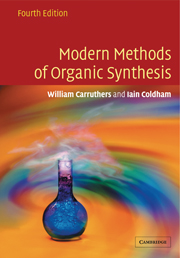Book contents
6 - Oxidation
Published online by Cambridge University Press: 05 June 2012
Summary
For practical purposes, most organic chemists mean by ‘oxidation’ either addition of oxygen to the substrate (such as epoxidation of an alkene), removal of hydrogen (such as the conversion of an alcohol to an aldehyde or ketone), or removal of one electron (such as the conversion of phenoxide anion to the phenoxy radical). Examples of oxidation reactions of alkenes have been described in Chapter 5, including epoxidation, aziridination, dihydroxylation and Wacker oxidation. This chapter therefore concentrates on oxidations of hydrocarbons, alcohols and ketones.
Oxidation of hydrocarbons
Alkanes
Under vigorous conditions strong oxidizing agents such as chromic acid and permanganate attack alkanes, but the reaction is of little synthetic use for usually mixtures of products are obtained in low yield. The reaction was traditionally used in the Kuhn–Roth estimation of the number of methyl groups in an unknown compound. This depends on the fact that a methyl group is rarely oxidized (the relative rates of oxidation of primary, secondary and tertiary C–H bonds are 1:110:7000) and hence the amount of ethanoic acid formed can be quantified.
The controlled oxidation of unactivated, saturated CH3, CH2 and CH groups is not uncommon in nature under the influence of oxidizing enzymes, but there are very few methods for effecting controlled reactions of this kind in the laboratory.
- Type
- Chapter
- Information
- Modern Methods of Organic Synthesis , pp. 370 - 404Publisher: Cambridge University PressPrint publication year: 2004

